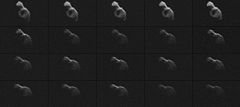2014 HQ124
 Zdjęcia radarowe planetoidy z Arecibo i Goldstone (8 czerwca 2014) | |
| Odkrywca | |
|---|---|
| Data odkrycia | 23 kwietnia 2014 |
| Charakterystyka orbity (2022-08-09) | |
| Przynależność obiektu | |
| Półoś wielka | |
| Mimośród | 0,2592[1] |
| Peryhelium | |
| Aphelium | |
| Okres obiegu wokół Słońca | 286 dni 17[1] godzin |
| Inklinacja | 26,37[1]° |
| Charakterystyka fizyczna | |
| Średnica | ok. 0,325[1] km |
| Jasność absolutna | |
2014 HQ124 – duża planetoida z grupy Atena, należąca do obiektów bliskich Ziemi i potencjalnie niebezpiecznych obiektów. Planetoida ma około 325 metrów średnicy, została odkryta 23 kwietnia 2014 w ramach programu NEOWISE. 8 czerwca 2014 znalazła się blisko Ziemi, w odległości niewiele większej niż trzykrotna średnia odległość Księżyca od Ziemi.
Odkrycie
Obiekt został odkryty 23 kwietnia 2014 w ramach programu NEOWISE[2].
Nazwa
Oznaczenie planetoidy 2014 HQ124 określa jedynie, kiedy obiekt ten został odkryty[3]. „2014” to rok odkrycia, „H” oznacza, że obiekt został odkryty w drugiej połowie kwietnia[3]. „Q124” oznacza, że był to 3116 obiekt odkryty w drugiej połowie kwietnia („Q”⇒16, 16+25·124=3116)[3].
Charakterystyka
Średnica obiektu wynosi około 325 metrów[1]. Szacuje się, że obiekty tej wielkości przelatują w pobliżu Ziemi przeciętnie co kilka lat[4]. 8 czerwca 2014 planetoida przeleciała w odległości 3,25 LD od Ziemi[1]. Uderzenie obiektu takiej wielkości w Ziemię wyzwoliłoby energię rzędu 2000 megaton TNT i utworzyło krater o wielkości około pięciu kilometrów[5].
Zobacz też
Do podobnej wielkości planetoid, które przeleciały w pobliżu Ziemi należą:
Przypisy
- ↑ a b c d e f g h i j 2014 HQ124 w bazie Jet Propulsion Laboratory (ang.). last obs. used 2021-05-31. [dostępu 2022-08-14].
- ↑ MPEC 2014-H67 : 2014 HQ124 (ang.). minorplanetcenter.net, 2014-04-28. [dostęp 2014-06-06].
- ↑ a b c New- And Old-Style Minor Planet Designations (ang.). minorplanetcenter.net. [dostęp 2014-01-03].
- ↑ Asteroid Discovered by NASA to Pass Earth Safely (ang.). jpl.nasa.gov. [dostęp 2014-01-03].
- ↑ "Beast" Asteroid to Fly by Earth on Sunday (ang.). scientificamerican.com. [dostęp 2014-01-03].
Linki zewnętrzne
- Diagram orbity 2014 HQ124 w bazie Jet Propulsion Laboratory (ang.)
- 2014 HQ124 w bazie Minor Planet Center (ang.)
Media użyte na tej stronie
Radar Images of Asteroid 2014 HQ124
June 12, 2014
http://www.jpl.nasa.gov/spaceimages/details.php?id=PIA18412
http://www.jpl.nasa.gov/news/news.php?release=2014-186&3
http://photojournal.jpl.nasa.gov/archive/PIA18412-640.mp4 => VIDEO
http://www.jpl.nasa.gov/video/index.php?id=1310 => VIDEO
NASA scientists used Earth-based radar to produce these sharp views -- an image montage and a movie sequence -- of the asteroid designated "2014 HQ124" on June 8, 2014.
2014 HQ124 is what scientists call a "contact binary": an asteroid that consists of two lobes that are in contact and that could have once been separate objects. About one in six asteroids in the near-Earth population has this type of elongated, "peanut" shape.
The asteroid is about 1,300 feet (400 meters) long and about half as wide. The radar images reveal a wealth of interesting features, including a large depression or concavity on the larger lobe as well as two blocky, sharp-edged features at the bottom on the radar echo. Scientists suspect that some of the bright features that persist from frame to frame could be surface boulders.
The 21 radar images were taken over a span of four hours. During that interval, the asteroid rotated a few degrees per frame, suggesting its rotation period is slightly less than 24 hours.
At its closest approach to Earth on June 8, the asteroid came within 776,000 miles (1.25 million kilometers), or slightly more than three times the distance to the moon. Scientists began radar observations of 2014 HQ124 shortly after the closest approach, when the asteroid was between about 864,000 miles (1.39 million kilometers) and 902,000 miles (1.45 million kilometers) from Earth.
The new views show features as small as about 12 feet (3.75 meters) wide. This is the highest resolution currently possible using scientific radar antennas to produce images. Such sharp views were made possible for this asteroid by linking together two giant radio telescopes to enhance their capabilities.
To obtain the new views, researchers paired the 230-foot (70-meter) Deep Space Network antenna at Goldstone, California, with two other radio telescopes, one at a time. Using this technique, the Goldstone antenna beams a radar signal at an asteroid and the other antenna receives the reflections. The technique dramatically improves the amount of detail that can be seen in radar images.
To image 2014 HQ124, the researchers first paired the large Goldstone antenna with the 1000-foot (305-meter) Arecibo radio telescope in Puerto Rico. They later paired the large Goldstone dish with a smaller companion, a 112-foot (34-meter) antenna, located about 20 miles (32 kilometers) away.
The first five images in the sequence -- the top row in the montage -- represent the data collected by Arecibo, and demonstrate that these data are 30 times brighter than what Goldstone can produce observing on its own. There is a gap of about 35 minutes between the first and second rows in the montage, or between the fifth and sixth frames in the video. The gap represents the time needed to switch from receiving at Arecibo to receiving at the smaller Goldstone station.
Each image in the montage and movie represents 10 minutes of data. Each frame has the same orientation, delay-Doppler dimensions and resolution (3.75 meters by 0.0125 Hertz).
For asteroids, as well as comets, radar is a powerful tool for studying the objects' size, shape, rotation, surface features and orbits. Radar measurements of asteroid distances and velocities enable researchers to compute orbits much further into the future than if radar observations were not available.
The Jet Propulsion Laboratory manages the Near-Earth Object Program Office for NASA's Science Mission Directorate in Washington. JPL is a division of the California Institute of Technology in Pasadena.
More information about asteroids and near-Earth objects is available at http://neo.jpl.nasa.gov/ andhttp://www.jpl.nasa.gov/asteroidwatch.